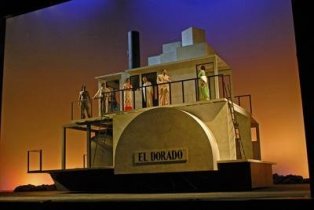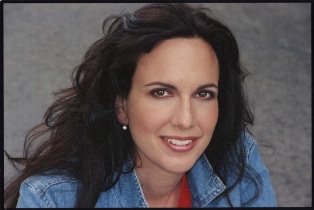
Donde estoy? Cincinnati Opera's "Florencia en el Amazonas"
Like its symbol,
the butterfly, Daniel Catan's "Florencia en el Amazonas" is a thing
of beauty.

Given its local
premiere by Cincinnati Opera Thursday night at Music Hall, it is also a rarity,
an opera in Spanish, a first not only for Cincinnati Opera but for any major
"Florencia" succeeds on many levels. Frankly neo-romantic, with arias, duets,
ensembles and choruses, it is first of all, lovely to listen to.
Think Puccini in
Spanish, or as opera artistic director Evans Mirageas put it in his delightful
You Tube video "The Top 10 Reasons to See 'Florencia en el Amazonas":
"If Puccini
had moved to
You can also hear
echoes of Benjamin Britten ("Sea Interludes" from "Peter
Grimes"), Wagner (when the storm breaks over the boat), Debussy, Ravel and
Richard Strauss (colorful scoring) and evocative Latin American rhythm.
Sung in Spanish with English supertitles, the
opera was beautifully performed by a cast of highly effective singing actors,
directed by British stage director Andrew Morton.
Heading the cast was American soprano
Alexandra Coku as Florencia, an opera diva returning incognito to her native
country to find her first love (Christobal, "the man "who gave me my
voice" hunts butterflies in the Amazon jungle). Her arias in act I and, transcendentally at
the end of act II, were filled with radiance and emotion.

"Florencia" was Coku's Cincinnati
Opera debut, as it was for all the characters except Turkish bass Borak Bilgili
as the Captain.
Among them was
Panamanian-American baritone Nmon Ford, virile, sonorous and agile as Riolobo
(he even flies), a mysterious personage who, in various guises, watches over
the boat. The young Mexican tenor Artur
Chacon-Cruz displayed a handsome voice complete with pristine high Cs, as the
Captain's nephew Arcadio, whose heart's desire is to pilot an airplane instead
of a riverboat.
American mezzo
Emily Golden and
Created for
Houston Grand Opera by, which co-commissioned "Florencia" with
The boat arrived
damaged from the opera's previous staging but was re-built by Cincinnati Opera
for the ample Music Hall stage.
Motorized with a driver insider, it puffs smoke and accomplishes scene
changes simply by turning to reveal another compartment or area on the boat's
upper and lower decks.
Turning it all
into magic is the lighting, designed by British-born Paul Pyant. Clouds, lightning, palm fronds,
richly-painted dawns and sunsets play off a scrim that descends behind the boat
as it departs down the river. Cut-outs of a crescent moon and orange sun rise
and set childlike against it. A touch of "magical realism," internal
states of mind played out in external metaphors, appears in the use of pink
foil "raindrops" ("cherry-colored," says the libretto) as a
storm, itself a metaphor, descends on the boat in the wake of the turbulent
emotions of act I.
Enhancing the
visual magic was a quintet of dancers, denizens of the
Catan was
inspired to write "Florencia" by Colombian author Gabriel Garcia
Marquez, whose "Love in a Time of Cholera" ends with an
American
conductor Steven Mercurio led the Cincinnati Symphony Orchestra with a sure
hand and the CSO's playing was typically fine though more projection of
individual voices would have been welcome now and then. The percussion section lent a great deal of
flavor on everything from mallet instruments and drums to thunder sheet. The Cincinnati Opera chorus appeared as
lively vendors in act I on the boat dock and offstage in response to the winged
Riolobo's invocations to the gods to save the
Is it too late
for Florencia and Christobal? Come to
the repeat at 7:30 p.m. Saturday at Music Hall and experience the magical, coup-de-theatre
conclusion.
Tickets at
www.cincinnatiopera.org, or call (513) 241-2742. Hear Mirageas and Catan in a pre-performance
conversation at 6:30 p.m. in the Music Hall auditorium